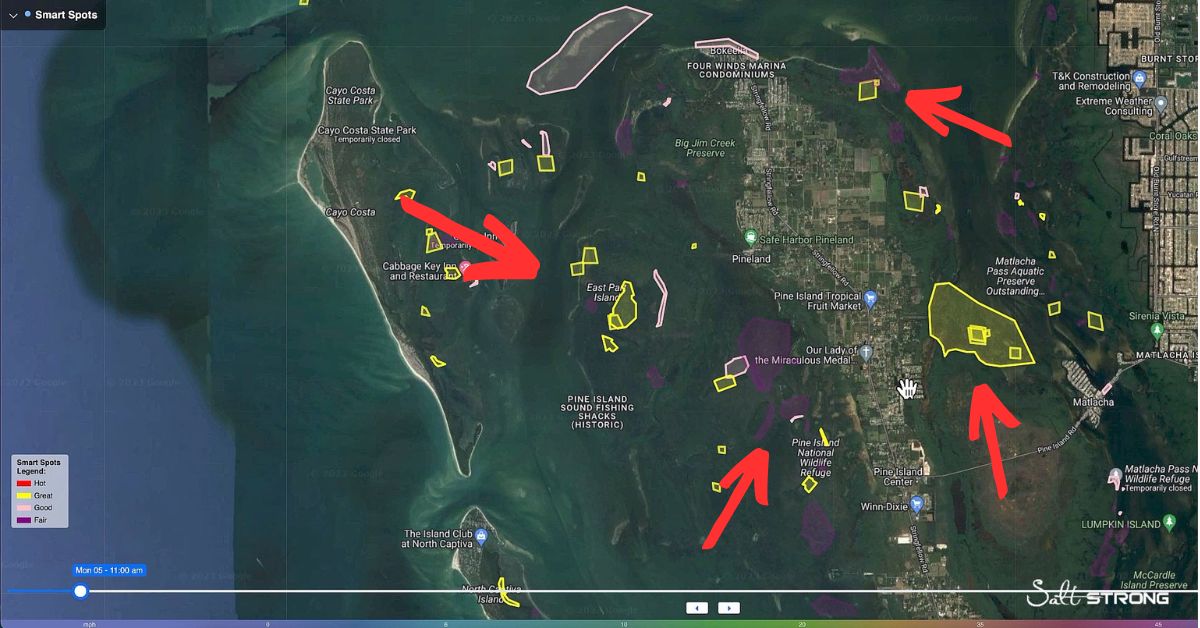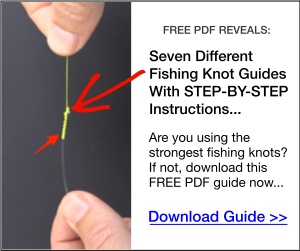The Best Types of Areas To Look For When Targeting Redfish, Seatrout, & Snook
- By: Tony Acevedo
- on

What are the best areas to look for when targeting redfish, seatrout, and snook???
It is a common goal for inshore anglers to set out and reel in an inshore slam.
In the video below, I’ll show you how you can use Smart Fishing Spots to find areas that hold all 3 species so you can come up with an inshore slam on your next trip out.
Take a look!!
Best Areas To Look For When Targeting Redfish, Seatrout, & Snook [VIDEO]

Gear Mentioned In The Video:
Smart Fishing Spots is exclusive software we developed for our Insider Members as a useful resource to find quality spots and effectively pre-plan fishing trips.
Insiders also use the platform while on the water to find new spots or gather more intel if things changed once they got to their pre-selected spot.
Right off the bat, you’ll notice we have a ton of different features and buttons under the Map Layers section.
Oyster Beds and Seagrass are a click away and will populate on the map instantly.
We also have a feature called Smart Spots that provides ideal fishing spots for your area based on the tide, weather, and other factors.
These resources help you narrow down where you should fish based on the species you’re after.
Speckled Seatrout
When targeting seatrout, the main areas to focus on are out on the grass flats in 1.5 to 3 feet of water.
When the tide moves out, you should move a bit further out to deeper sections of the flat.
Areas with potholes and broken bottom structure are ideal zones for trout.
Snook
When I’m fishing for snook, I like to fish chokepoints or areas with moving current.
Spots in between islands or oyster beds paired with a deep trough and moving current are examples of quality snook spots.
Chokepoints in the middle of two islands or points are also noteworthy areas for targeting snook.
Something else to keep in mind is the water level and if there are mangroves in the area.
If the water is pushed into the mangroves, snook will often sit in cut-outs in the mangroves.
Pitching lures into these areas is a great way to spark a bite.
Redfish
Redfish will likely be pushed up into muddy coves and they’ll often be close to the bottom.
They are scavengers that cruise muddy areas in search of crabs, shellfish, snails, or clams to eat.
Unlike trout and snook both of which are ambush predators.
Backwater coves of 1-2 feet depending on the tide are ideal zones for redfish.
Lure Selection
It can be a hassle to have to switch lures based on the species you are targeting.
If you want a lure that appeals to all 3 species mentioned, then go with a paddletail lure.
Any of our 3.5-inch Slam Series Paddletails work year-round and trigger strikes from seatrout, snook, redfish, and plenty more species.
As far as color choice, I would go with the lighter Slam Shady color if the water is clean.
Or if the tide is moving out and the water is dirty, I recommend fishing with the Gold Digger lure color which is black with gold flake.
Gold works really well in dirty water because it does not require as much light as other colors to flash.
The hooks I rig these lures up on depends on where I’m fishing.
If I’m out fishing an open flat of more than 3-4 feet deep, I’ll use a jighead.
If I’m fishing close to structure like mangroves or oysters, I recommend a weedless rigging hook.
Our 3/0 Hoss Helix Hook weighing 1/8oz. is all-purpose and shines in shallow water near structure.
Salt Strong Insider Club
Keep in mind, the areas I highlighted in this video are just examples of the types of areas you should look for when targeting redfish, seatrout, or snook.
Spots are not the only way to catch fish.
Other factors like wind direction, tidal flow, time of the day, and seasons all come into play when inshore saltwater fishing.
This is where we most often see anglers struggle – putting all of these variables together to effectively hit the water and find fish.
This is what we do here at Salt Strong.
We give our members the resources and tools they need to consistently find and catch more fish in less time while saving money.
Smart Fishing Spots, Smart Fishing Tides, Mastery Courses, and Tackle Discounts are just the tip of the iceberg.
If you aren’t catching the quantity or quality of fish you want, then think about joining us in the Insider Club.

Finding The Fish Help
In order to help make sure that you are targeting the right areas based on the latest feeding trends and upcoming weather forecasts, make sure to use the following 3 resources because they will save you a ton of time.
1. Weekend Game Plans (updated weekly)
These regional game plans will show you exactly what types of spots to target in under 10 minutes… just click the video to start, and you’ll be informed on what to do on your next trip.
2. Smart Fishing Spots Platform (updated every 15 minutes)
This exclusive software literally shows you where the most fish are likely to be feeding based on exactly when you’ll be fishing. It factors in the tides, wind, and weather to help you quickly see which areas to target throughout the day.
3. Community Reports (live feed)
The Insider Community platform is what you can use to see what is biting near you, and you can get to know other members who fish in your area. Plus, you can use it to keep a log of your catches so you can use past trips to help predict future catches.
Related categories:
STOP WASTING TIME ON THE WATER!
Do what the “SMART ANGLERS” are doing and join the Insider Club.
Here’s what you’ll receive today when you join:
- Weekly fishing reports and TRENDS revealing exactly where you should fish every trip
- Weekly “spot dissection” videos that walk you through all the best spots in your area
- Exclusive fishing tips from the PROS you can’t find anywhere else
- Everything you need to start catching fish more consistently (regardless if you fish out of a boat, kayak, or land).










I do like using the interactive fishing spots map. I hope the next time I’m there I need to use it and catch additional fish. I did notice that the pass in between Little Gasparilla Island and Gasparilla Island (Boca Grande) was labeled Boca Grande Pass. I thought Boca Grande Pass was the pass on the south end of Boca Grande in between Boca Grande and Cayo Costa.
Hey Patrick! Yes the main Boca Grande Pass is to the south but both are commonly referred to as the same.
Yea lately Tony smart spots has been acting a little off for me I have noticed that no matter what time of year the same spots are predicted to be great to good which I found strange as we club members all know fish move to different locations depending on the tide and time of year
We are currently adding and tweaking a lot of the spots. Keep in mind though there are going to be some spots that can be good for extended periods throughout the year based on weather conditions.
This app is really cool. You can find every single oyster bed, grass flat or under water structure spot. So, to find you perfect fishing SPOT, where we are ASSUMING that fish hanging out, there is no better and simpler way than using this app. Unfortunately for ME, 95% of this spots are not accessible without boat or kayak…. and I don’t have one.. 🙁
Fishing from shore is definitely limited and can take a bit more time when planning and researching areas to fish. Be sure to check out some of these videos we have on shore fishing. There are also plenty more you can find using the search bar on the site. Just type in “shore fishing” or anything related to that:
https://www.saltstrong.com/fishing-tip/land-based-spots-to-target-redfish-seatrout-snook-flounder/
https://www.saltstrong.com/fishing-tip/finding-land-based-spots-east-central-florida/
https://www.saltstrong.com/fishing-tip/how-to-plan-a-successful-land-based-fishing-trip-mini-course/